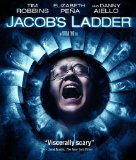We begin in Vietnam, where the unit of which Jacob Singer (Tim Robbins) is a member comes under attack. Jacob is bayonetted, and as he struggles with his wounds, the film flashes forward to his post-Vietnam life in New York City. He works for the post office, is divorced, is still grieving over the death of his youngest son (Macauley Culkin), and is living with his new girlfriend (Elizabeth Pena). He is also being tormented by visions of demonic figures. And then suddenly this life turns out to be a dream, and he’s at home with his wife and all of his kids are alive. Or is that a dream? And what really happened in Vietnam?
I’m going to assume that most people who are interested in this film have, in fact, already seen it. But in case you haven’t, spoilers follow, and should you wish to avoid them, skip to the Video evaluation. Now I’m going to waste another sentence just in case your eyes drift. You’re all gone? Good. The last time I saw this film was twenty years ago, during its initial theatrical run, and I was left feeling bitterly disappointed: after all the build-up of conspiracy and mystery, we’re left with the he-was-dying-all-along gambit? In other words, my sense was of a horror film that was compellingly original and frightening for most of its running time, and then squandered that good will by a hackneyed conclusion.
Watching it again, I find it necessary to shit my position somewhat. Knowing where the film is heading does, I think, make it work better, and the story does make a certain amount of sense. So I guess I no longer see the ending as a total cop-out. The work as a whole is still a bit messy, though. While more visceral, and in the final analysis, more ambitious than the similarly-themed The Sixth Sense, it is nowhere near as tidy as that monster hit, with all kinds of loose ends. A flawed work, then, but a committed, serious attempt at delivering an adult, intelligent horror movie. Worth revisiting.
Video
It’s amazing how quickly technology ages. 1990 doesn’t seem that long ago (he said, dating himself), but the print, while in great shape, nevertheless reveals its age in that the Blu-ray format surpasses what the source material can provide. The transfer, then, is beyond reproach. Colours, blacks, flesh tones, contrasts – they’re all excellent. But there is visible grain, too, which, again, has nothing to do with the quality of the transfer itself. The aspect ratio is the 1.85:1 anamorphic widescreen.
Audio
The 5.1 sound belies the age of the film visible in the picture quality. All things considered, there’s some pretty spectacular sound design present here, with lots of disturbing use of surround with the sound effects. The music is strong, and the dialogue is neither buried by the aforementioned effects or music, nor prone to distortion.
Commentary Track: Director Adrian Lyne has plenty to say about the making of the film, and it’s interesting to hear him revisit some decisions (such as the removal of a quasi-exorcism scene) and express uncertainty over whether he made the right choice.
Special Features
Building Jacob’s Ladder: (26:29) More from Lyne in this interesting retrospective, but also plenty from screenwriter Bruce Joel Rubin.
Deleted Scenes: (13:24) Three of them, with optional commentary from Lyne.
Theatrical Trailer and Teaser.
Final Thoughts
While I remain doubtful as to whether the film ultimately pulls off its project, it sure is nice to see it swing for the bleachers.





